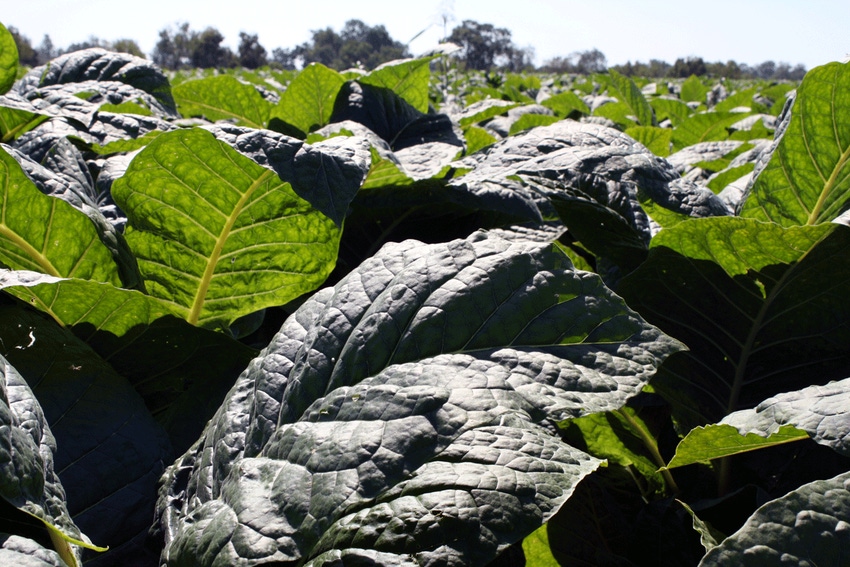June 18, 2014

The 2013 season was a rare one indeed for tobacco farmers. There was so much rain over so long a period that it seemed that no amount of supplemental nitrogen was too much. Flue-cured grower David Etheridge of Broadway, N.C., applied enough supplemental nitrogen to be a significant cost factor, but he has no regrets.
“I wouldn't have made much tobacco without it,” he said in May. “There's no doubt about it. I more than made my money back from every pound of supplemental nitrogen I put out.”
But now we are in another year and another season, and agronomists say farmers should put the 2013 fertility experience out of their minds.
“We don't want our farmers using 2013 as a yardstick for 2014,” said Don Nicholson, regional agronomist with the North Carolina Department of Agriculture. “It is easy to over-fertilize when supplementing nitrogen.”
The program he recommends is to put out something dry, like ammonium sulfate (21-0-0-24) mixed with KMag/Sul-Po-Mag (0-0-22-22), to meet the sulfur needs and some of the nitrogen needs. Then make up the remainder of the nitrogen requirements with 24S or liquid urea as needed.
“I strongly discourage applying too much nitrogen at one time,” he said.
Etheridge buys all of his nutrients from FCI of Raeford, N.C., and gets much of his fertility advice from FCI's representative, David Dycus, along with a lot of help from Nicholson.
Small applications best
“We look at each individual nutrient in preparing a plan for each customer,” said Dycus. “For nitrogen, we consult with the farmer about what amount he wants to apply. His experience is going to provide the best information as to what works on his farm. About 75 to 80 pounds of nitrogen is usually enough.”
But Etheridge had to go as high as 130 pounds per acre in 2013 on some fields.
Dycus recommends 200 to 225 pounds per acre of potassium on most soils in his area. “That is higher than standard recommendations, but we are convinced we get better yields by doing it,” he said.
“Phosphorus is the last nutrient we look at,” said Dycus. “We don’t normally include phosphorus in our recommendation since in eastern Carolina because the levels are almost always high.
“But the situation may be a little different this year. There might have been some leaching last year. At the current price, if you apply 20 to 25 pounds of phosphorus to the acre, it only costs $8 an acre. You might sleep better at night by applying it. “
Phosphorus is necessary for early season growth and root development. If you apply phosphorus, your plants may grow off a little quicker.
“But we will still have some farmers who choose to apply zero phosphorus, and that should work out fine,” said Dycus.
Secondary nutrients
Among the secondary nutrients:
-Boron has become a concern recently. “We began to observe boron deficiencies several years ago,” said Dycus. “Now, we are seeing so much boron deficiency in this area that we recommend three quarters of a pound per acre on all tobacco fields. We have a few fields that might go up to one pound per acre.” If boron is deficient, the tobacco gets symptoms like heart-shaped leaves, he said. “The midrib vein will be curved, and on the inside of the curve, you find no foliage. It looks a little like hornworm damage.” Boron deficiency is being seen more often because of the trend to using high analysis fertilizer blends that don't contain it, said Dycus.
-To reduce the chance of sulfur deficiency on deep, sandy soils, add 20 to 30 pounds of sulfur (S) per acre from the N-P-K fertilizer every year, said Matthew Vann, North Carolina State University Extension tobacco specialist. “Sulfur deficiency occurring before layby can be corrected by banding one hundred to 150 pounds of Sul-Po-Mag or potassium sulfate (0-0-50) as soon as possible after the deficiency is identified,” he added. “However, sulfur deficiency on soils less than about 12 inches to clay is often temporary, even when no extra sulfur is applied, because adequate sulfur is usually contained in subsoils.” It will be absorbed as roots reach this depth, he said.
Potash burley concern
The big [fertility] concern for burley growers in Virginia is the shortage of a sulfate source of potash (0-0-50).
“I am urging burley growers to use a tobacco grade fertilizer [which is low in chlorine],” said Danny Peek, Virginia District Extension director in Abingdon, Va. “But I am afraid some will use a muriate source of potash, and that can cause a drop in cured leaf quality. You can run into curing problems, especially if you have a wet fall, because the tobacco will contain so much moisture.”
Use a potassium fertilizer that has a sulfate source. “It's a little more expensive but quality is less of a concern, advises Peek.
There might be one other possibility, said Bob Pearce, University of Kentucky Extension tobacco specialist. If you could get sulfate of potash within a month of transplanting, you could get good results by scattering it over the top with a fertilizer buggy.”
But be sure the tobacco is completely dry when you do it. If it’s wet, there is a danger of burning.
About the Author(s)
You May Also Like




